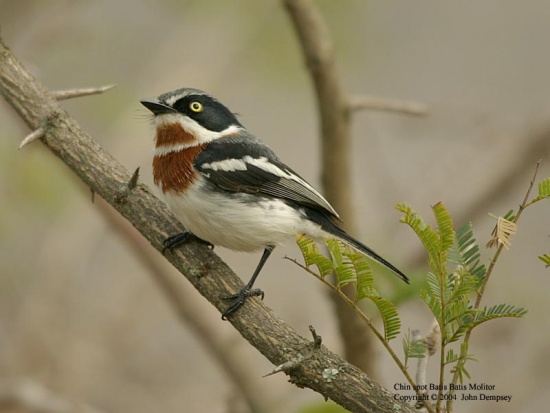| Line 1: | Line 1: | ||
;[[:Category:Batis|Batis]] molitor | ;[[:Category:Batis|Batis]] molitor | ||
| − | Alternative names, White-flanked Batis, Chinspot Puffback-Flycatcher | + | '''Alternative names, White-flanked Batis, Chinspot Puffback-Flycatcher''' |
[[Image:Chinspot_Batis.jpg|thumb|550px|right|Photo by jdbirdman <br />Location: Umfolozi Game Reserve, [[KwaZulu-Natal]], South Africa]] | [[Image:Chinspot_Batis.jpg|thumb|550px|right|Photo by jdbirdman <br />Location: Umfolozi Game Reserve, [[KwaZulu-Natal]], South Africa]] | ||
[[Image:Male_Chinspot_Batis_CollinBax_KrugerNP.jpg|thumb|450px|right|Photo by CollinBax <br />Location: Crocodile Bridge, [[Kruger National Park]], South Africa]] | [[Image:Male_Chinspot_Batis_CollinBax_KrugerNP.jpg|thumb|450px|right|Photo by CollinBax <br />Location: Crocodile Bridge, [[Kruger National Park]], South Africa]] | ||
Revision as of 11:43, 30 July 2010
- Batis molitor
Alternative names, White-flanked Batis, Chinspot Puffback-Flycatcher
Identification
Length 12-13 cm; mass 8-14 g.
Differs from other Batis species by its pure white flanks (and the chestnut breast band and throat patch in the female).
Distribution
Sub-Saharan Africa.
Taxonomy
Batis molitor has four subspecies:1
- B. m. pintoi
- B. m. puella
- B. m. palliditergum
- Southern Zaire to Namibia, Botswana, Malawi and north-western South Africa
- B. m. molitor
- Southern Mozambique to eastern South Africa
Habitat
Woodland, savanna and riverine thickets.
Behaviour
Active birds; constantly foraging and hawking insects and spiders in the canopy of trees or bushes.
Breeding
The nest is a small cup of plant fibres and spider web, decorated with lichen; built by both sexes on a horizontal branch. One to four eggs are laid and incubated for 16-18 days by the female. Both adults feed the young.
References
- Clements JF. 2007. The Clements Checklist of Birds of the World. 6th ed., with updates to October 2008. Cornell University Press. ISBN 9780801445019
- Gibbon G. 2002. Roberts' Multimedia Birds of Southern Africa: Version 3. John Voelcker Bird Book Fund. www.sabirding.co.za





